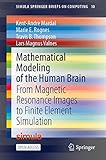Mathematical Modeling of the Human Brain [electronic resource] : From Magnetic Resonance Images to Finite Element Simulation / by Kent-André Mardal, Marie E. Rognes, Travis B. Thompson, Lars Magnus Valnes.
Tipo de material: TextoSeries Simula SpringerBriefs on Computing ; 10Editor: Cham : Springer International Publishing : Imprint: Springer, 2022Edición: 1st ed. 2022Descripción: XVI, 118 páginas32 ilustraciones, 25 ilustraciones in color. online resourceTipo de contenido:
TextoSeries Simula SpringerBriefs on Computing ; 10Editor: Cham : Springer International Publishing : Imprint: Springer, 2022Edición: 1st ed. 2022Descripción: XVI, 118 páginas32 ilustraciones, 25 ilustraciones in color. online resourceTipo de contenido: - texto
- computadora
- recurso en línea
- 9783030951368
- 003.3 23
Introduction -- Working with magnetic resonance images of the brain -- From T1 images to numerical simulation -- Introducing heterogeneities -- Introducing directionality with diffusion tensors -- Simulating anisotropic diffusion in heterogeneous brain regions -- Concluding remarks and outlook -- References -- Index.
Open Access
This open access book bridges common tools in medical imaging and neuroscience with the numerical solution of brain modelling PDEs. The connection between these areas is established through the use of two existing tools, FreeSurfer and FEniCS, and one novel tool, the SVM-Tk, developed for this book. The reader will learn the basics of magnetic resonance imaging and quickly proceed to generating their first FEniCS brain meshes from T1-weighted images. The book's presentation concludes with the reader solving a simplified PDE model of gadobutrol diffusion in the brain that incorporates diffusion tensor images, of various resolution, and complex, multi-domain, variable-resolution FEniCS meshes with detailed markings of anatomical brain regions. After completing this book, the reader will have a solid foundation for performing patient-specific finite element simulations of biomechanical models of the human brain.
No hay comentarios en este titulo.
